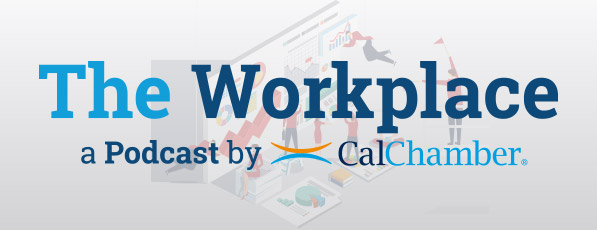The latest two episodes of The Workplace, a CalChamber podcast, deal with common issues employers face — misclassifying workers and not following meal and rest break rules.
Employee Misclassification
There are so many different types of workers: hourly employees, managers, supervisors, exempt employees, and independent contractors. But how do you classify each one under California labor laws? In an episode of The Workplace, CalChamber Executive Vice President and General Counsel Erika Frank discusses exempt employee misclassification with employment law expert Jennifer Shaw. They discuss the differences between exempt and nonexempt employees and the common mistakes employers make when classifying their employees as exempt.
One of the most common mistakes employers make is misclassifying an hourly worker as an exempt employee. “To be exempt in California, you have to meet two tests: a salary test and a duties test,” says Shaw.
According to California labor laws, salary means the employee’s pay is “not subject to variation based on the quality or quantity of work,” Shaw tells Frank.
When employees are exempt, the employer does not pay overtime, but the exempt employee has more independence than an hourly employee. “Many employees want to be exempt because they don’t have to clock in and out, they can take a longer lunch, they can come and go as they please, and they are still getting the same amount of pay,” adds Frank.
“It is very important for employers to know that the law presumes employees to actually be nonexempt,” Shaw says. “So, it is always an employer’s burden to show that an employee is exempt. Exempt means exempt from all of those wage-and-hour laws that we freak out about: rest breaks, meal periods, overtime, on call, reporting time pay, callback pay. All of that does not apply when you have an exempt employee.”
It is important for employers to understand how easily this issue can lead to legal implications. “What employers need to know is it is not difficult for a lawyer to say you have misclassified or you haven’t given rest breaks or meal periods and it is too expensive to defend,” Shaw tells Frank. “There is no evidence an employer can use or have to rebut the employee’s assertion,” Frank adds.
Communication is key when it comes to making changes to employees’ classification. Shaw suggests reverse engineering to make sure employees know they will not be taking a pay cut. It is also crucial to discuss with employees the positives of being nonexempt, such as overtime pay, rest and meal periods, when changing their classification.
For more information, see CalChamber’s Top Story.
Meal and Rest Breaks at the Office
Although California’s meal and rest break rules are intended to give hourly employees time to take breaks during their shifts, problems can arise if employees skip their breaks or if employers don’t offer them. In another episode of The Workplace, CalChamber Executive Vice President and General Counsel Erika Frank discusses meals and breaks in the office with attorney Michael Nader, shareholder with Ogletree Deakins, who focuses his practice on defending wage-and-hour class actions. In the podcast, they discuss meal and rest break rules and the importance of tracking employees’ breaks to protect employers against class action lawsuits.
California’s Labor Code outlines the rules employers must follow when it comes to providing nonexempt employees their meal and rest breaks.
For meal breaks, Nader explains, it is important for the employee to be exempt from all duty and allowed to leave the premises if he/she wishes. “The employer must relinquish control over the employees’ activities,” he says.
Similarly, with rest breaks, employees can use these paid, on-the-clock, net 10-minute periods any way they like.
When employees decide to skip their meal and rest breaks, legal issues can sometimes arise — often in the form of class action lawsuits.
To protect employers from class actions, it is important to track employees’ breaks and encourage employees to take their breaks for meals and rest.
“Employers should have robust, detailed policies demonstrating to the employees that rest breaks are provided and that they are expected to take them,” Nader explains.
For more information, see CalChamber’s Top Story.
Subscribe to The Workplace
Subscribe to The Workplace on Google Play, iTunes, PodBean, Tune In and Stitcher.
Webinar
CalChamber is presenting a live webinar, Classifying Exempt Employees in California, on Thursday, June 20, 2019, 10 a.m. to 11:30 a.m. (Pacific).







